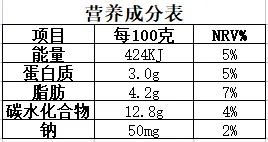What is a nutrition label?
According to the provisions of the "General Rules for Nutrition Labeling of Pre-packaged Food" GB28050-2011, the nutrition label is a description
of the nutrition information and characteristics of the food provided to consumers on the label of pre-packaged food, including three parts:
the nutrition facts table, nutrition claim and nutrition facts function claim, which is a part of the pre-packaged food label.
The contents of the nutrition label
Food nutrition labels mainly include the "nutrition facts table" in the form of a table, and on this basis to explain the level of nutrients and health
effects of the "nutrition claims", "nutrition claims". The nutrition facts list is the core of the nutrition label.
Pre-packaged food labels are like the "ID card" of food, which contains a lot of nutritional information, and we should learn to read it when buying food.
How to read the nutrition facts list
To give you a "chestnut" :
In the picture of the nutrition facts table, the percentage of nutrient reference value of protein contained in every 100 grams of yogurt is 5%,
which means that drinking 100 grams of this yogurt meets 5% of our protein intake today.

If the whole bottle contains 300 grams, when we drink it, we will have completed 15% of our protein intake for today. This is far from enough,
suggesting that we also need to get protein from other foods.
【 Flour 】
Whole wheat flour > Rich powder > Snow powder > Wheat core powder
Whole wheat flour has low processing precision and retains more nutrients such as B vitamins and dietary fiber, which is not only suitable for ordinary healthy people,
but also suitable for special people such as obesity, constipation and diabetes.
After selecting the flour, the nutritious pasta suitable for the elderly should meet the following three criteria.
If you choose flour with a high protein content, which contains gluten and albumin, your blood sugar will rise slower.
【 Noodles 】
Date on the wet side, sodium on the dry side
The water content of fresh noodles is about 30%, the shelf life is short, and it is generally sold on the spot; The moisture content of fresh wet surface is generally 20% to 25%, and the shelf life is longer than that of fresh surface. Buy fresh noodles and fresh wet noodles, the most important thing is to see the production date, and eat as soon as possible.
[m]
Brown rice > Preserved rice > milled rice
There are japonica rice and indica rice, japonica rice is the main rice to eat in daily life. Indica rice is usually large and sticky,
and is mainly used for making rice and rice noodles.
【豆制品】
蛋白质北豆腐>内酯豆腐>南豆腐
The tofu we often eat can be roughly divided into three categories: north tofu, South tofu and inner fat tofu. The type of tofu purchased can be determined from the third item of the ingredients list (food additives).
来源:综合自北京卫视、健康时报








